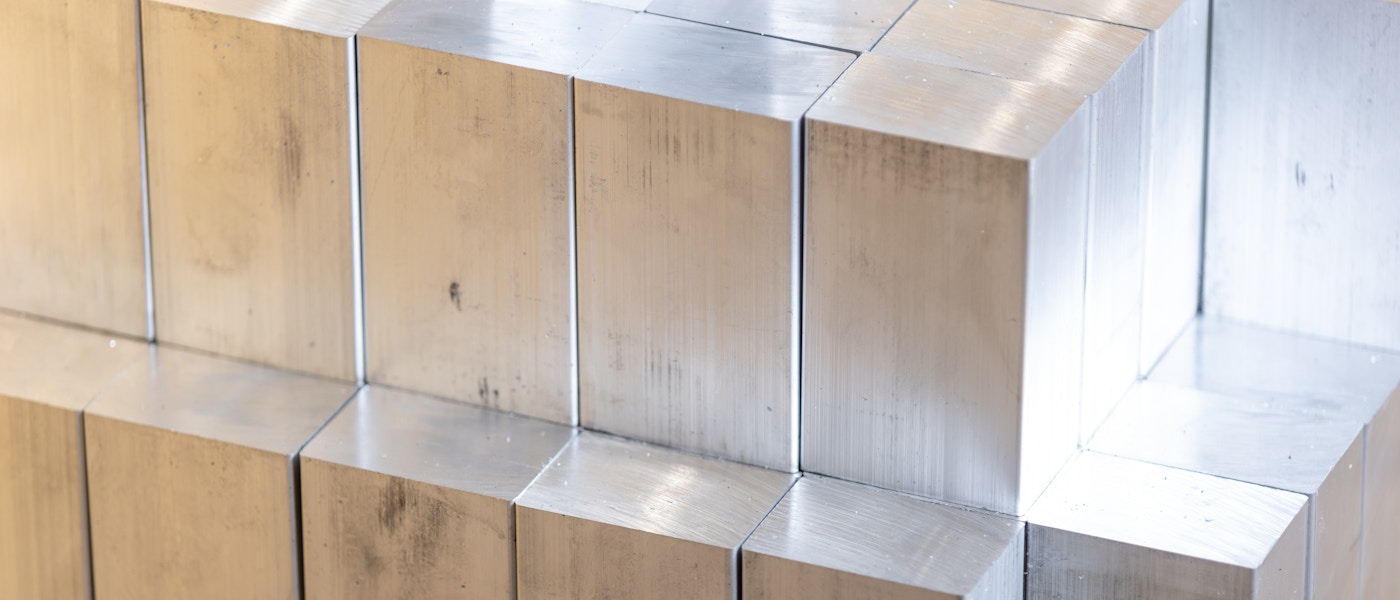What is aluminium?
Aluminium is an exceptionally versatile material that can be used for multiple applications throughout all of today’s leading industries.
Aluminium in its raw form is durable, weather resistant, aesthetically attractive and very easy to fabricate.
It is the most abundant of earth’s natural metals and when combined with other natural elements, its potential uses grow exponentially.
This creates a range of different compositions that all have varied characteristics and practical applications, these are known as alloys.
It is aluminium’s alloying potential that gives it a standing all of its own in the metals market and makes it the first choice for countless suppliers and businesses.
These days wherever you look, from the biggest architectural endeavours to small intricate parts requiring innate precision, aluminium is the solution that many turn to.
Here at Righton Blackburns we can source any desired aluminium grade, and guide you through the whole process from comparing the strengths of different metals to the inception and completion of your project, all the time being attentive to your needs and any changing requirements as a project evolves.
Common uses of aluminium bar
Aluminium bars begin by being extruded or rolled and this initial step makes them highly suitable for a number of diverse applications.
This unrivalled adaptability sees multiple uses within the architecture, aerospace, automotive, engineering and marine industries, to name a few.
Indeed, the unique alloying properties of aluminium allow for an incredible versatility highly valued throughout almost all trades and industries.
These many advantages make aluminium a much-developed natural resource, and here at Righton Blackburns, we aim to be at the cutting edge of all such advancements.
The benefits of aluminium bar
One of the standout benefits of using aluminium bar is aluminium’s natural strength-to-weight ratio, this much-valued attribute makes it a nailed-on choice in the worlds of engineering and architecture.
Add to this extreme durability in harsh conditions, and an ability to withstand significant pressure and it can easily be seen why aluminium is in such high demand.
Of all its desirable qualities, perhaps the highest valued is its corrosion resistance, and when this is coupled with its lightweight nature it becomes a valuable combination that has seen it replace steel throughout industries worldwide, a trend that seems set to continue.
Aluminium's ability to resist corrosion is in large part due to the way in which aluminium responds to the threat of a corrosive substance, the metal produces its own layer of oxide that forms a protective barrier on its surface.
And due to its ease of alloying, other elements can also be added to bolster this resistance even further.
Another key benefit is that aluminium can be painted, lacquered or anodised allowing for a choice of finishing methods or design requirements.
Aluminium bar is also very formable, allowing for a greater ease of fabrication, cutting, bending and machining.
Further advantages include its substantial ductility, reflexivity and conductivity, and of course, its hygienic properties that allow widespread use throughout the food and medical trades.
The most common aluminium bar alloy grades in production today
Aluminium alloy 6061
6061 is known as a precipitation-hardened alloy. The key is that it is aluminium alloyed with silicon and magnesium to offer superb corrosion resistance and exceptional machining characteristics.
Other elements can also be added to the mix such as titanium and iron to achieve specific results.
It is also one of the easiest grades to weld and responds well to both hot forming and cold working and as such is easy to fabricate, cut, drill, deep draw, stamp and bend.
6061 can be used in many grade mixes, many of them pre-tempered saving time and money.
Among the most utilised 6061 grades are 6061-O (solution based), 6061-T4, 6061-T6 (solution based and artificially aged), and 6061-T651 (an equivalent to T6 when rolled).
Common Grades
This depends on whether it has been aged, and the temper used.
6061-O:
This grade is an annealed material and has a maximum tensile strength of up to 18,000 psi, with a maximum yield strength of less than 8000 psi. It also has a stretch limit of 25/30%.
6061-T4:
A higher tensile strength of at least 30,000 psi and superior yield delivery of 16,000 psi, but lower stretch limit of 16%.
6061-T6
Showing the highest tensile strength of these three common grades at 42,000 psi, and yield performance of 35,000 psi, but a stretch limit of 8% (10% with thicker sections).
6061: Uses in industry
Aluminium alloy 6061 is often used in round or flat bar form.
Commonly found in multiple trades such as building and architecture, it can be utilised in several distinct ways.
In building for example it may be used for:
Roofing
Heating and cooling systems
Curtain walls
Siding
Stairways
Renovations of historic buildings
It is also used in the base construction of yachts and small utility boats, as well as bicycle parts and frames.
Aluminium alloy 7075
7000 series alloys are in very common use across multiple industries, and the principal among these is the 7075 alloy, quantities of zinc and magnesium are added to the raw aluminium, and then small adjustments with copper and chromium can be made to suit the more exact purpose.
Also used for wings and fuselage components, the 7075 alloy uses zinc as its main alloying element, this greatly improves its strength values and is highly utilised in the aerospace industry due to its comparative weight versus steel.
When tempered 7075 also benefits from good levels of corrosion resistance and improved strength-to-weight ratio.
The comparative downsides of 7075 are that it can't be welded and it does have less corrosion resistance than other alloy mixtures, it is also expensive to make.
7075: Other uses in industry
Aluminium 7075 can be found in all of the major industries and is used in many different ways, some less common uses are:
As rock climbing equipment
Bicycle components
Radio controlled cars
M16 rifle parts
Common grades
7075-0
When not heat-treated 7075-0 has a peak tensile strength of no higher than 40,000 psi and a maximum yield of no more than 21,000 psi, as well as a stretch limit of between 9-10%.
7075-T6
With a peak tensile strength between 74,000 and 78,000 psi and a yield value of between 63,000 to 69,000, the T6 temper has a minimal stretch limit of 5 to 8%
7075-T651
Also showing a high peak tensile strength of between 67,000 and 78,000, and yield value of between 54,000 and 67,000, but also suffers a lower stretch limit of 3 to 9%.
Aluminium alloy 2024
The main alloying element of 2024 is copper which enhances its strength properties while also creating strong fatigue resistance.
However, 2024 does not weld well and it is of middling performance when it comes to machinability.
It also lacks the corrosion resistance properties of other more versatile aluminium grades but is able to be anodised or used in clad form, both of which offer some protection.
Common uses for aluminium 2024 bar include:
Structural components
Fuse parts
Gears and shafts
Missile parts
Truck wheels
Computer parts
Boasting the multiple properties of high strength-to-weight performance, good fatigue response, significant tensile strength and high levels of machinability, aluminium 2024 finds its use in many industries.
More commonly made in round bar form, it is most often used in transport, aerospace, the computer industry and many other trades where the parts need to be of a precise nature.
Among its key values are a tensile strength of up to 70,000 psi, as well as good fatigue and reasonable corrosion resistance levels, this also makes it a suitable candidate for less demanding marine environments.
Its ease of machining is also a strong attribute allowing for fast manufacturing of even custom parts.
Aluminium alloy 6063
Next on our list is grade 6063, principally alloyed with silicon and magnesium, 6063 shows good tensile properties and fabricability while also offering reasonable corrosion resistance levels. It also offers multiple anodising and painting options.
Common industry uses
Widely used within architecture, the 6063 grade bar is exceptionally versatile allowing multiple end products with the same base formula.
This is due to its adaptable chemical characteristics and how it responds to post-extrusion processes, such as welding, heat forming and anodising.
It is one of the better choices when it comes to anodising as it can be made to match the colour of other metals it is being mixed with, such as a 3003 or 5052 alloy. Anodising also adds to its corrosion resistance level.
Aside from its highly prized aesthetic performance, 6063 also provides significant strength, is easy to extrude and is one of the more affordable alloy composites.
Commonly used for door framing, furniture, windows, moulds and trimming, one of its principal advantages is its visual appeal.
In its usual T6 tempered state, 6063 has a peak tensile strength of 35,000 psi and tensile yield value of 31,000 psi, compared to pre-tempered values of 27,000 and 21,000 respectively.
When using grade 6063 there are multiple heat-treating methods available including ageing precipitation, solution-based heat treatment and annealing.
In regards to the solution the temperature must be 970° Flop, while for annealing heating should be at 775° Flop, and ageing at 350° F.
Aluminium alloy 6082
We complete our list with a metal alloy in extremely common use. Aluminium 6082 is usually treated with a T6 tempering creating a medium-strength alloy with some fantastic characteristics.
Corrosion resistance is chief among these, as well as significant post-forming resistance to rust and its ability to weld.
6082 is also well suited to machining and can be found throughout the construction and building industries, as well as multiple everyday trades such as farming.
Just a few of its many common uses include:
Bridge building
Ore skips
Cranes
Milk churns
Beer barrels
Transport
6082 is made up of manganese, magnesium, and silicon, with varying smaller amounts of iron, copper, zinc, titanium and chromium mixed when needed.
This mix is one of the newer alloy discoveries and has seen it replace aluminium alloy 6061 in many environments.
This is due in large part to the greater concentration of manganese which allows better control of the grain structure which in turn creates a stronger metal.
The downsides are that it doesn’t cope well when thin-walled specifications are needed and it doesn’t finish quite as smoothly as other 6000 series metals.
Round, flat or square bar?
Different applications benefit from different strengths and properties, some alloys are better suited to the values of round bar specifications, while others suit flat bar characteristics, when it comes to aluminium, the metal’s versatility is often able to bridge this gap, adapting to all forms of production with minimal changes, please see below some of the more common distinctions between the various extrusions.
Round Bar
For round bar projects, aluminium 7075, 6063 and 6061 are the more common grades in use today.
Architecturally sound, they are also an immediate choice for structural applications, machine and equipment parts and many types of frames.
Each grade has its various performance characteristics and while some excel in some fields, others will do better in others so please call us to find out what product will suit your project.
Aluminium rods
Another classification of aluminium bar, the aluminium rod is designed to withstand multiple pressures including water, air and heat.
It performs well in multiple environments and can bear a large amount of stress before its breaking point.
As well as the applications already listed, aluminium round bars can be adapted and used for almost anything across almost any industry, because of this a complete list is beyond the framework of this post but more can be found on our other posts and pages.
Flat Bar
Aluminium flat bars are often applied to projects requiring a high-strength performance.
7075, 6063 and 6061 as in round bar form, adapt extremely well to this task.
More on flat bar alloys
As well as the more common grades of aluminium, there are also many other grades that find their uses in more niche operations.
Many of these lesser-known varieties are often found in flat bar form and are classified below:
Aluminium alloy 2011
Not as tough as other aluminium alloys, this flat bar is used for making machine components and high-precision parts. Its characteristics make it suitable to fast production and easy machining.
Aluminium alloy 2017
Excellent machining values and suitable for heat treatment. Ideal for screws, pulleys and rivets among others.
Aluminium alloy 6262
Offering good mechanical strength and corrosion resistance, the addition of bismuth to its chemical composition allows for a fantastic surface finish and excellent machinability, common uses are camera parts, nuts, couplings, hinge pins and valve components.
Recycling
These days, a large part of deciding on a material to use is its ability to be recycled.
For this purpose aluminium has no equal, it can readily be melted down and made ready to begin the extrusion process from scratch, it does this without losing any of its natural chemical properties and is therefore almost 100% recyclable and ticks every box in this category.
Re-melting aluminium is also an exceptionally cost-effective way to reuse metal and generates a fraction of the overall energy that other comparative metals may need.
With its ease of reproduction, much of today’s ‘new’ aluminium materials are in fact recycled metals that have been used multiple times but still perform to exactly the same standard.




